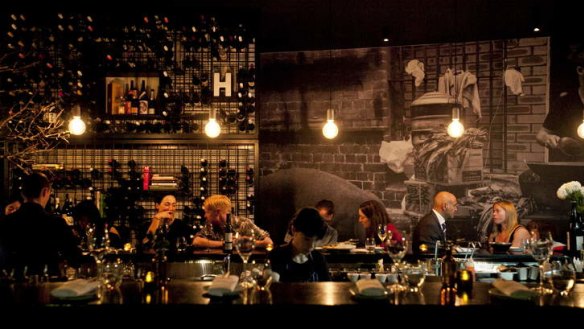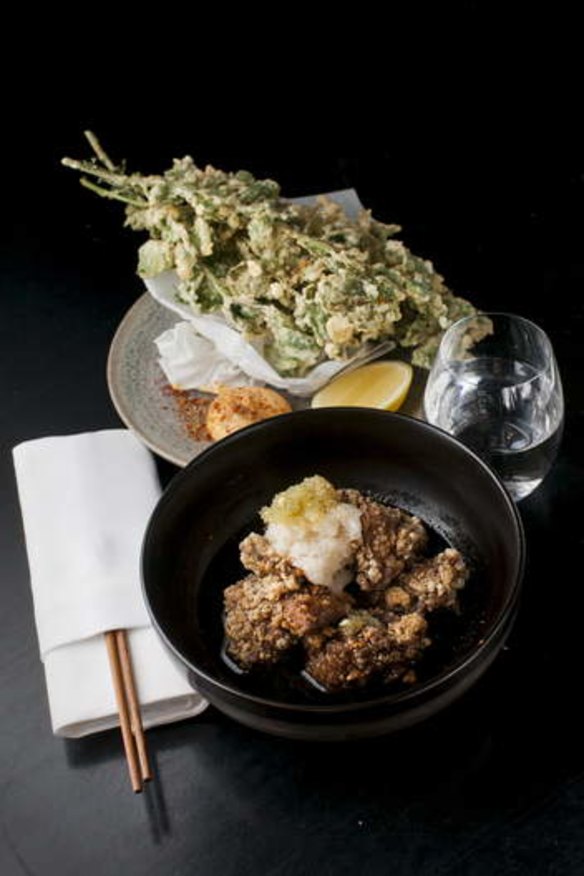Bar H

14.5/20
Asian$$
Food travels. It goes with you when you take a plane, go away for a weekend or emigrate across the world, floating across borders, arriving when you do.
In a new land, you make the food you grew up with, and add to it, evolving and revolving your own personal food culture. So chi-chi Chinese restaurants in Hong Kong stole sashimi from Japan because they loved its clarity and purity, and Japan developed its own version of Chinese food, called chuka (the Japanese word for China). And when a bright young chef decides to play out his passion for Japanese-style Chinese food in Australia, it's definitely intriguing.
It's an interesting progression for Hamish Ingham, who was the long-serving chef at Billy Kwong before opening Bar H in Surry Hills in 2010. It started as a modern European bistro, but soon embraced contemporary Chinese cooking instead. Then - ambition? boredom? chutzpah? - dictated a brief detour into wood-fired cooking at the Woods in the Four Seasons Hotel. Now Ingham's back, consolidating the home base with a new subterranean dining room and an east-meets-east menu that sounds genuinely exciting. Chinese bread and pork butter. Pickles, pork skin, wasabi. Eggplant, miso and jamon.

Another ongoing Ingham obsession is Australia's native ingredients, which lend themselves so well to Asian cooking. Not so much chuka cuisine, then, as chooka.
The most successful demonstration of this Japanese/Chinese/Australian mash-up is saltbush tempura ($14). It's fantastic. The long woody stalks have been swished through batter and hot oil without being over-battered or over-fried. Stripping off the almost succulent leaves just feels so bloody Australian, like plucking salty, spicy crisps off a lagerphone.
Prepare for a certain obliqueness to menu descriptions. Prawn toast ($8), for instance, is no crisp-fried prawn-topped bread, but a steamed brioche bun incorporating prawns, tamari, shallots and ginger, then sesame-seeded and deep-fried. It's a bit weird, the way a lot of fusion cooking in Japan is a bit weird. Taco rice, curry noodles, mayonnaise potato pizza, I'm talking about you.
Another out-there dish is a tightly balanced mix of seared fresh bonito, creamy sea urchin custard and pine mushrooms ($21) topped with fine shavings of katsuobushi, fermented, dried skipjack tuna rather like Spanish mojama.
A big steaming bowl of ramen made with udon noodles looks a treat, draped with sliced duck, scallop, purslane and raw egg yolk ($18). The chicken stock base doesn't have the depth of pork bones, but it's cleaner and more delicate.
There's heaps more flavour in Japanese fried chicken ($27), the well-marinated thigh meat sent out as petrified nubbins of igneous chicken rock, topped with grated daikon, yuzu, soy and finger lime.
As well as an orientally oriented cocktail list and a great selection of Junmai sake, there's a rollicking good wine list that runs to the vibrant, earthy 2012 Sorrenberg gamay from Beechworth ($89), which Jancis Robinson calls one of the most exciting gamays she has ever tasted. Agreed.
Custard tart ($14) is not the golden, eggy Chinese daan tart you might expect. The low-slung wedge of English-style baked custard tart is dusted, rather curiously, with fennel pollen and wattleseed; a slightly forced marriage.
It's a brave move to concentrate on a fusion cuisine driven by the Japanese palate; but we can rely on Ingham to continually evolve and surprise us. The one constant here is the casual charm of the paint-it-black, wall-of-wine, tiny-tabled, neighbourly dining experience. The food will, no doubt, keep travelling.
THE LOWDOWN
Best bit: A new direction with Asian food.
Worst bit: No chopstick rests (as yet).
Go-to dish: Japanese fried chicken, $27.
Terry Durack is chief restaurant critic for The Sydney Morning Herald and senior reviewer for the Good Food Guide. This rating is based on the Good Food Guide scoring system.
Restaurant reviews, news and the hottest openings served to your inbox.
Sign up- More:
- Surry Hills
- Sydney
- Asian
- Accepts bookings
- Bar
- Licensed
- Private dining room
- Degustation
- Family-friendly
- Good for groups
- Date night
- Vegetarian-friendly
- Outdoor dining
- Wheelchair access
- Bar H Dining
- Reviews
